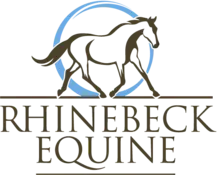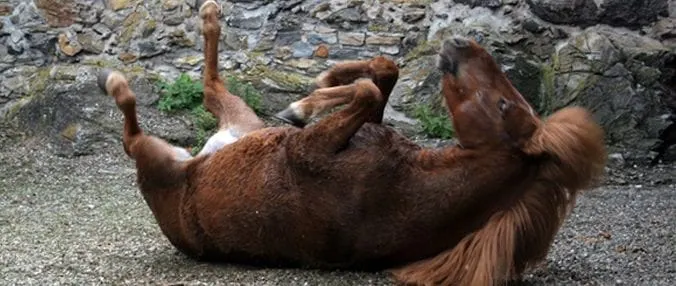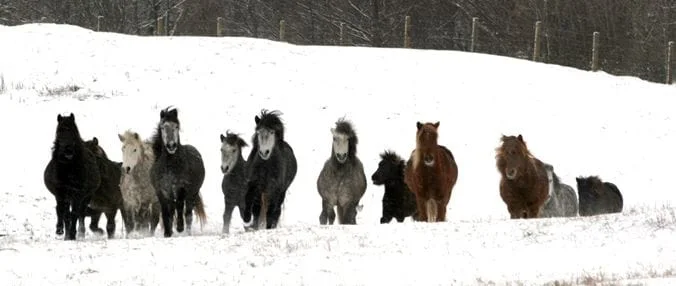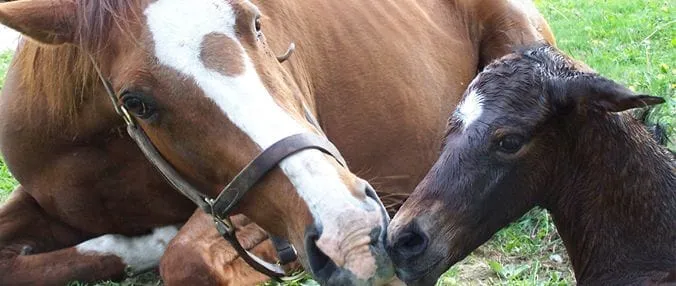Digital and conventional radiography are available both in the field and at our hospital. Our powerful 300mA hospital X-ray machine enables us to obtain radiographs of shoulders, backs, chests, pelvises and other areas that are difficult to image with portable equipment. In the field, each of our ambulatory veterinarians has an x-ray machine and a generous number of film cassettes in order to utilize conventional radiography.
In addition, Rhinebeck Equine has the Eklin Digital Radiography system available to all of our veterinarians.

Digital radiography has several advantages over conventional systems. The same X-ray generator is used but the image is developed with a digital plate and can be viewed almost instantly on a laptop computer. This takes the place of processing a piece of film at the clinic. Digital radiography allows for a more immediate diagnosis and helps us to assess, at the time of the visit, the need for additional views or exposures necessary to make an accurate diagnosis and allows immediate decisions to be made regarding appropriate treatment. The digital images can be manipulated to provide optimal contrast and brightness and can be stored and transmitted electronically. In addition, use of digital radiology for prepurchase exams can allow a more timely decision process and enhances the communication between the buyer and the examining veterinarian.
Ultrasound technology allows the examination of the internal structure of the body. Our veterinarians use ultrasound frequently to diagnose injuries to tendons and ligaments, as well as to examine lung tissue, umbilical remnants, abdominal structures, and unusual swellings. In addition, ultrasound is used extensively in reproductive evaluations. Sound waves of a specific frequency are generated and reflected back to the probe which is held on or around the structure to be imaged. A computer processes the image, which is then depicted on a viewing screen. In general the lower the frequency, the greater the penetration but the lower the resolution (ability to see detail). Probes with a frequency of 2.5-3.0 MHz are typically used to image internal organs (heart, kindey, spleen, intestines),or certain areas of the back, while 5.0 MHz is used for reproductive work (uterus, ovaries, pregnancy), and 7.5-10.0 MHz is used for tendon and ligament imaging.
Each of Rhinebeck Equine’s ambulatory veterinarians is equipped with an ultrasound unit with 5.0-7.5 MHz capability. In addition, we have a portable digital PICO ultrasound with a 10 MHz capability which is used for most of our tendon and ligament imaging in the field. The hospital is equipped with the advanced Biosound Megas ultrasound unit, which allows comprehensive and detailed evaluation of body structures with enhanced resolution, whether the problem is in a body cavity or an extremity.
Endoscopy allows the evaluation of the upper respiratory tract as well as the esophagus and urogenital structures in the standing, sedated horse. Our ambulatory veterinarians use a portable fiberoptic endoscope, while our hospital is equipped with a videoendoscope, allowing all present to view the image on a video screen. Flexible endoscopes are used widely in veterinary and human medicine. They are chiefly diagnostic tools – either for direct viewing of otherwise inaccessible areas of the body, or by allowing collection of small tissue samples for biopsy (by passing special forceps down the “biopsy channel” of the scope). However, flexible endoscopes are also utilized therapeutically, either in conjunction with a surgical laser (“transendoscopic laser surgery”) or for endoscopically guided injections (“intralesional injection”) for treatment of certain masses or tumors.
Videogastroscopy is performed in the hospital setting, and provides the only definitive method of diagnosing gastric ulcers. Horses under competitive stress, such as race horses and sport horses, commonly develop gastric ulcers. Examinations of the stomach with the gastroscope are performed in a standing sedated horse that has been held off food and water for 12 hours. Outpatient appointments for this service are typically scheduled in the morning to limit the time fasting.
Nuclear Scintigraphy. Our MIE nuclear scintigraphy unit enhances our diagnostic imaging capabilities. Nuclear scintigraphy has proven to be the standard for diagnosis of many orthopedic injuries that are not easily localized using traditional examination and imaging techniques. The technique is extremely sensitive in that it enables detection of many injuries or inflammatory conditions prior to the development of any radiographic abnormalities.
A nuclear scintigraphic scan or “bone scan” is carried out by administering an intravenous dose of a drug labeled with a radioactive marker to the horse. The drug is preferentially taken up by bone in higher concentrations where the bone is more metabolically active. This includes areas of injury or inflammation, such as fractures or arthritis, as well as normal areas such as physis or “growth plate”. A few hours after the drug is injected, the horse is scanned with a gamma camera that detects the radioactivity. A computer translates this information into an image of that particular area of he body or skeleton. The images are examined for “hot spots” – areas of abnormal increased radioactivity that indicate the location of potential problem or injury. This information is then corrrelated with the horse’s clinical history, lameness examination results, and results of any radiographs or sonograms to reach a defensive diagnosis. The technique is very safe, in that this dose of radiation is extremely low and the scan is carried out with the horse standing and lightly sedated.
We are excited to offer you and your horses this improved level of service and care.





